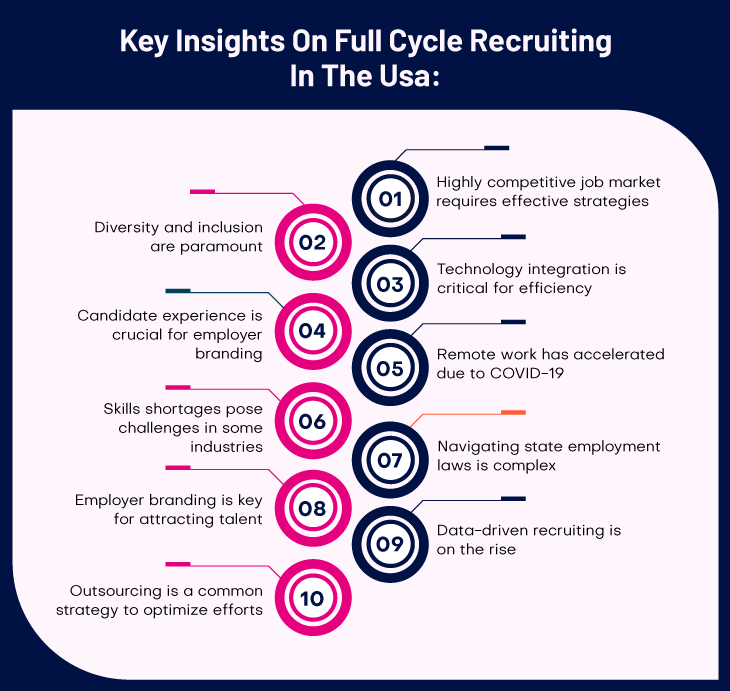Topics: Full Cycle Recruiter, Full Cycle Recruiting, Outsource Full Cycle Recruiting
Full Cycle Recruiting Guide USA: Best Practices, Tips & FAQs
Posted on September 19, 2024
Written By Sakshi Sharma

Full cycle recruiting refers to the entire process of hiring a candidate, from the initial job posting to the final offer and onboarding. It encompasses all the steps involved in identifying, attracting, evaluating, and hiring qualified candidates for a job opening. Here are some best practices, tips, and strategies to make full cycle recruiting in the US more effective:

Key Insights on Full Cycle Recruiting Process in the USA
Full cycle recruiting in the USA is a multifaceted process that offers several key insights into the intricacies of talent acquisition in this competitive job market. Firstly, the USA boasts a highly competitive job market across a wide range of industries, making it imperative for organizations to have effective recruiting strategies to attract and retain top talent. Secondly, diversity and inclusion have become paramount, with companies increasingly prioritizing these aspects in their hiring processes to create more inclusive workforces.
Additionally, the integration of technology plays a significant role, with applicant tracking systems (ATS), artificial intelligence (AI), and data analytics being widely used to streamline and enhance the recruiting process. The candidate experience is another critical consideration, as candidates have more choices than ever before, and negative experiences can tarnish an organization’s reputation.
The COVID-19 pandemic has accelerated the adoption of remote work, prompting recruiters to adapt to virtual interviewing and onboarding processes. Skills shortages, particularly in fields like technology and healthcare, pose a challenge, necessitating proactive efforts to identify and attract candidates with the required skill sets. Furthermore, navigating varying state-specific employment laws and regulations adds complexity to the recruiting landscape, highlighting the importance of compliance.
Employer branding has emerged as a key element for attracting talent, with companies investing in showcasing their culture and values to align with potential candidates. Data-driven recruiting is on the rise, with metrics such as time-to-fill, cost-per-hire, and quality of hire helping recruiters make informed decisions. Continuous learning and professional development are essential in this ever-evolving field. Lastly, organizations often explore outsourcing or partnering with specialized firms to optimize their full cycle recruiting efforts.
In the midst of these insights, recruiters in the USA must remain adaptable, tech-savvy, and candidate-centric while staying attuned to market trends and continually refining their recruitment strategies to secure the best talent in this dynamic environment.

FAQs: Full Cycle Recruiting
Full-cycle recruiting is a comprehensive approach to talent acquisition that involves every stage of the recruitment process, from the initial job posting to the final onboarding of a new hire. It’s a critical function within HR and talent acquisition departments across various industries in the United States. However, for those new to the concept or looking to deepen their understanding, a set of frequently asked questions (FAQs) can serve as a valuable starting point. In this FAQ guide, we’ll explore the fundamentals of full-cycle recruiting, breaking down its stages, differentiating it from other recruitment roles, and even delving into the advantages of outsourcing. Whether you’re an HR professional or an aspiring recruiter, these answers will help you navigate the intricacies of full cycle recruiting.
What is full cycle recruiting?
Full cycle recruiting is an end-to-end process that involves all stages of hiring, from job requisition and candidate sourcing to interviewing, assessment, and making the final job offer. It also includes onboarding and sometimes extends to post-hire activities.
Which are the first 3 steps of the 360-degree recruitment process?
The initial steps of full cycle recruiting typically include job requisition, job posting, and candidate sourcing. Job requisition involves identifying the need for a new hire, while job posting advertises the position. Candidate sourcing entails finding potential candidates through various channels.
What are the stages of full cycle recruiting?
Full cycle recruiting usually consists of several stages, including job requisition, job posting, candidate sourcing, candidate screening, interviewing, assessment, reference checks, offer negotiation, onboarding, and sometimes even post-hire activities like probationary reviews.
What is the difference between a recruiter and a full cycle recruiter?
While a recruiter focuses primarily on candidate sourcing and screening, a full cycle recruiter handles the entire hiring process, from sourcing to onboarding. Full cycle recruiters have a more comprehensive role, whereas recruiters often specialize in one aspect of the hiring process.
What is the biggest advantage of outsourcing full cycle recruiting?
The primary advantage of outsourcing full cycle recruiting is cost-efficiency. It allows companies to tap into the expertise of specialized recruitment firms, reduces in-house recruitment costs, and often results in faster hiring processes.
What other terms are used for full cycle recruiting?
Full cycle recruiting is also known as 360-degree recruiting, end-to-end recruitment, and complete recruitment. These terms are often used interchangeably to describe the same comprehensive approach to hiring talent.
Originally published Sep 19, 2024 07:09:25, updated Apr 16 2025
Topics: Full Cycle Recruiter, Full Cycle Recruiting, Outsource Full Cycle Recruiting







